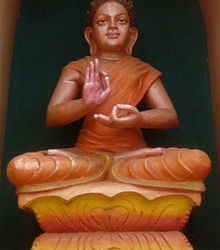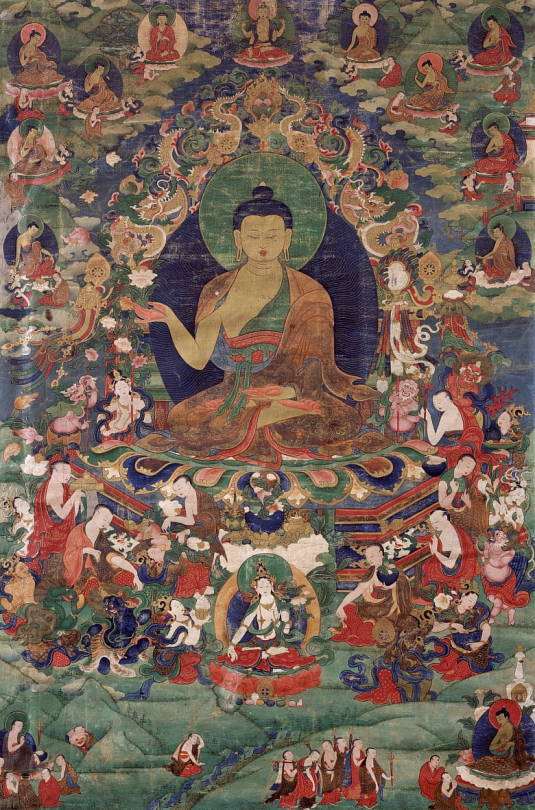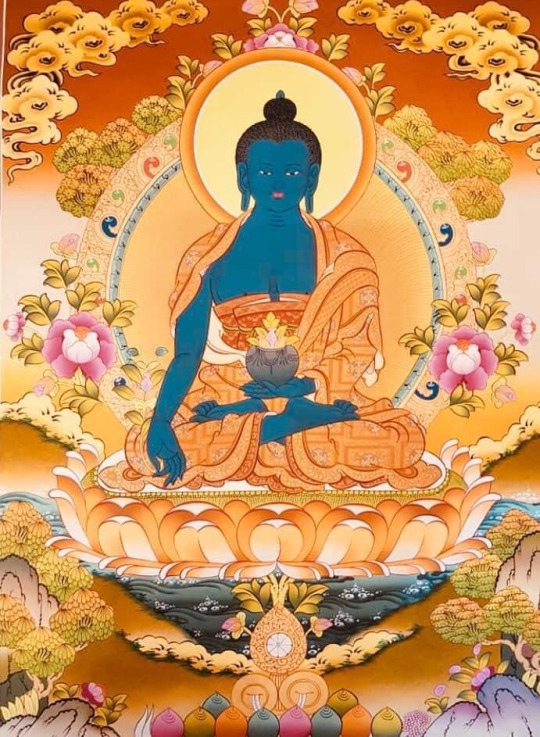#shakyamuni
Explore tagged Tumblr posts
Text
Academic Buddha Biography PDF
I found scans of Gotama Buddha: A Biography Based on the Most Reliable Texts (2000) on Internet Archive. I've combined both volumes into a single PDF.
Note: Vol. 1 is missing the bibliography (for some reason), but vol. 2 has it.

37 notes
·
View notes
Text
The Buddha in different religions/beliefs.

Firstly, who is the Buddha?:
The historical Buddha was a prince named Siddhartha Gautama who lived 2500 years ago in what is today northern India/Nepal. He was born into a warrior clan known as the Shakya, which is why he is often called Shakyamuni, “Sage of the Shakyas.” He is the one to later abandon worldly attachments, become enlightened, and found Buddhism.

The Buddha in Hinduism.
Some Hindus consider the Buddha as the 9th avatar of Vishnu/Dashavatara, The Buddha was integrated into Vaishnavism, it was also believed the Buddha’s wife, Yasodhara, was the avatar of the wealth Goddess Lakshmi, though Buddhists deny this, so as other Hindus who identify the 9th avatar of Vishnu to another being who was also called “buddha”.

The Buddha in Christianity.
Called St. Josaphat (Budhasaf) of India, The story of St. Josaphat tells of a prince in India who is converted to Christianity by a monk, despite his father's attempts to prevent it. The monk and prince are later honored as saints in Christendom. The Buddha was honored as a Christian saint for about a thousand years, but this wasn't recognized until the mid 19th century.

The Buddha in Hellenism.
Buddhism had a big influence on ancient Greeks, in which they would identify Buddhist beings with Greek beings, the Greeks were also the first ones to make Buddhist statues. Heracules (or Zeus) was identified with The bodhisattva Vajrapani, whom was seen as Buddha’s protector. There also was a Syncretism between The Buddhist Goddess Hariti & Greek goddess tykhe.

The Buddha in Taoism.
Some Taoist believe that the Buddha was a reincarnation of Laozi, the founder of Taoism. Some also believe he was either on the same power-level as the Jade emperor, the Taoist king of heaven, or stronger than him. 'Buddha' is absorbed wholly into the Taoist cosmology, becoming another term used to describe the generative tissue at the source of all things in both the mental and physical realms.

The Buddha in Shinto.
Buddhism & Shinto are mostly seen highly entwined in Japan. The buddha is called Shaka in Japanese & was transformed into a powerful Japanese deity, whom coexisted with the Shinto gods. Buddhist temples were often attached to Shinto shrines. A Shinto temple would sometimes have a priest of that shrine read a Buddhist sutra in which Shinto events took place.
#buddhism#buddha#buddhist art#hinduism#christianity#hellenism#Taoism#daoism#shinto#shintoism#religions#the buddha#Siddhartha#gautama#siddhartha gautama#shakyamuni buddha#shakyamuni#desiblr#lotus-list#buddhistwitch#desi#desi tag#mahayana#vajrayana#theravada#zen
38 notes
·
View notes
Text

If he is able to gain this freedom, he will not be perplexed by anyone on earth.
— Takuan Sōhō, The Unfettered Mind: Writings from a Zen Master to a Master Swordsman, transl by William Scott Wilson, (2012)
#Japanese#Takuan Soho#The Unfettered Mind#Writings from a Zen Master to a Master Swordsman#William Scott Wilson#(2012)#Essence#Shakyamuni#Buddha#Siddhartha Gaudama
15 notes
·
View notes
Text

A painted image of seven deities dating to the Kamakura period (1185-1333) at Tōji Temple (東寺) in Kyoto: on the left, Fugen Bodhisattva (普賢菩薩) & Jizō Bodhisattva (地蔵菩薩); in the middle, Amida Buddha (阿弥陀如来) & Shakyamuni Buddha (釈迦如来) & Yakushi Buddha (薬師如来); on the right, Kannon Bodhisattva (観音菩薩) & Fudō Myōō (不動明王)
Image from "東寺の菩薩像" [Images of Bodhisattvas at Tōji] published by 東寺宝物館 [Tōji Treasure Museum], 1993, page 55
#japanese art#buddhist art#京都#kyoto#東寺#toji#普賢菩薩#fugen#地蔵菩薩#地蔵#jizo#阿弥陀如来#amida#amida nyorai#amitabha#釈迦如来#shaka nyorai#shakyamuni#薬師如来#yakushi nyorai#yakushi#観音菩薩#観音#kannon#avalokitesvara#不動明王#fudo myoo#真言宗#shingon#crazyfoxarchives
43 notes
·
View notes
Text
What is the Lotus Sutra?
One of the most influential sacred texts in Buddhism is the Lotus Sutra. The Lotus Sutra has had a tremendous influence on Buddhism as we know it today. Much of Buddhist culture as we know it either came from the Lotus Sutra, or was influenced by its ideas and teachings. Not everything, of course. But the influence is hard to ignore. If you know the Lotus Sutra, a lot of things about Buddhist…
6 notes
·
View notes
Text

Sakyamuni (GS)
#sakyamuni#buddha#gautama#buddhism#silent warrior#shakyamuni#noble truths#religious art#original#collage
8 notes
·
View notes
Text

(Much thanks for @spotty-is-slumberous for lovely art for this holiday card! :D)
This is a very special time of the month for many Buddhist traditions. Just a few days ago, on May 8th, the Japanese traditions were celebrating Hanamatsuri. Today, May 15th, the Chinese traditions like the one I took refuge and precepts under are celebrating Fódàn. On May 23rd the Theravada traditions are celebrating Vesak. And on May 26th the Tibetan traditions are celebrating Saga Dawa.
All these various holidays and festivals celebrate the birth, enlightenment, and/or passing into parinirvana of Shakyamuni Buddha, the buddha of our current age and founder of all of our traditions. I hope all buddhists, whatever date they celebrate, can take this timeto reflect on Shakyamuni's story and draw from it inspiration to continue their practice.
Like all buddhas and bodhisattvas Shakyamuni was an ordinary being once, that through continous effort across countless lifetimes achieved the greatest accomplishment. The ultimate promise of his message is that if we follow the path prescribed by him we too can achieve it.
南无本师释迦牟尼佛
Homage to our original teacher, Shakyamuni Buddha!
9 notes
·
View notes
Text

http://www.dharmasculpture.com/
These standing Buddha statues are depicted holding alms bowls. In Buddhism, the begging bowl, or alms bowl, is one of the simplest but most important objects in the daily lives of Buddhist monks. It is primarily a practical object, used as a bowl in which to collect alms from lay supporters. The simple begging bowl, has, over time become a symbol of the Buddha's teachings of non-attachment.
http://www.dharmasculpture.com/category/new-arrivals.html
#woodenbuddhastatue#woodenbuddhacarving#buddha#buddhastatue#cambodianbuddha#khmerart#cambodianart#handcarvedbuddhastatue#handcarvedbuddha#buddhistalmsbowl#buddhistmonks#shakyamuni#shakyamunibuddha#buddhistgreatguardiankings#buddhistbeggingbowl#buddhism#khmerbuddhastatues#cambodianbuddhastatues#buddhistart#dharmasculpture
2 notes
·
View notes
Photo

Shakyamuni Buddha
Farbe auf Seide
9 notes
·
View notes
Text
Wishing you an auspicious Saka Dawa!!
Happy Saka Dawa! Saka Dawa is the most important festival in the Tibetan Buddhist world and commemorates the birth, enlightenment, and parinirvana (passing) of Lord Buddha Shakyamuni. Image taken from Internet During this month, the merits of good deeds are said to be multiplied one hundred million times. So, if we just commit to avoiding negative thoughts for this month and decide to engage…

View On WordPress
#Birth#Buddha#Buddha Birthday#Buddha enlightenment#Buddha parinirvana#Buddha Shakyamuni#Buddhism#enlightenment#mahaparinirvana#parinirvana#Raffaello Palandri#Raffaello Palandri Buddhist Master#Saka Dawa#Shakyamuni#Tibetan#Tibetan Buddhism
11 notes
·
View notes
Text

3 notes
·
View notes
Text

The 15th day of the 2nd lunar month Commemorating the #Nirvana Day of #Shakyamuni #Buddha 🌿 An auspicious day for: 📖 Reciting scriptures & chanting Buddha’s name 🕯️ Offering incense & practicing vegetarianism 💛 Cultivating compassion through charity & good deeds
🔮 Discover your #destiny with a personalized #ziweidoushu reading today!
https://ngocnga.net/zi-wei-dou-shu/?utm_source=tumblr&utm_medium=social&utm_campaign=ziwei
1 note
·
View note
Note
Hmm do you have anymore things or stories related to Rahula👀👀
I remember a specific story of the Buddha having the fatherly instinct of looking for Rahula at night when everyone else was asleep, Turns out Rahula was sleeping outside bc a monk slept on his bed & didn’t want to disturb him. The reason why the Buddha had an instinct was when Rahula was asleep, a snake (?) tried to bite him, so Buddha adventured out and made Rahula sleep in his own bed for safety.
I thought it was kinda a cute story.
I may or may not make Rahula art in the future
4 notes
·
View notes
Text
Gilt Bronze Buddha Shakyamuni
[et_pb_section fb_built=”1″ _builder_version=”4.16″ global_colors_info=”{}” theme_builder_area=”post_content”][et_pb_row column_structure=”1_2,1_2″ _builder_version=”4.16″ background_enable_color=”off” custom_padding=”16.1406px|0px|0|0px|false|false” global_colors_info=”{}” theme_builder_area=”post_content”][et_pb_column type=”1_2″ _builder_version=”4.16″ custom_padding=”|||”…
#18TH#Amsterdam#art#Bronze#BUDDHA#Century#China#Chinese#Dynasty#Gautama#GILT#Ming#Qing#Shakyamuni#Siddhartha#Sino-Tibetan#Tibet
0 notes
Text

A painted image of the Buddha Shakyamuni (釈迦如来 Shaka Nyorai) surrounded by the Sixteen Divine Protectors of the Great Wisdom Sutra
Color on silk dating to the 15th century from the collection of Tōji Temple (東寺) in Kyoto
Image from "東寺の如来・祖師像" [Images of Buddhas and Patriarchs at Tōji] published by 東寺宝物館 [Tōji Treasure Museum], 1994, page 53
#japanese art#buddhist art#釈迦如来#釈迦#shaka nyorai#shakyamuni#京都#kyoto#真言宗#shingon#crazyfoxarchives#arte japonés#arte budista
24 notes
·
View notes
Text
Who Dwells In This House?
I’ve been mulling over a certain quotation of Honen (法然, 1133–1212), the 12th century Buddhist monk credited with spreading the Pure Land tradition in Japan, and thus founder of movements such as Jodo-Shu and Jodo-Shinshu: “All of our deeds in the realms of saṃsāra result from ties with the three worldly passions of greed, anger, and ignorance. Understand that when the worldly passions of greed,…
#Amida#Buddhism#Dhammapada#Honen#Japan#Jodo Shinshu#Jodo Shu#Nembutsu#Pali Canon#Pure Land#Shakyamuni
5 notes
·
View notes